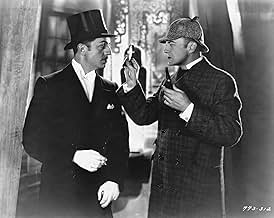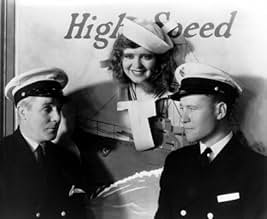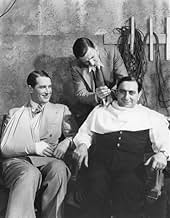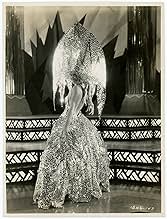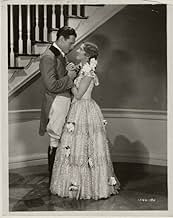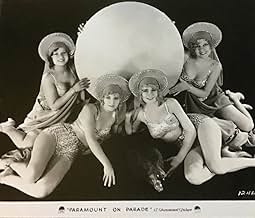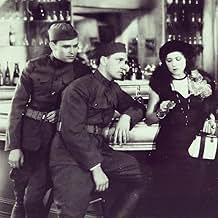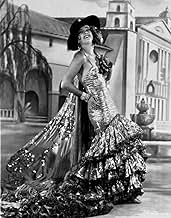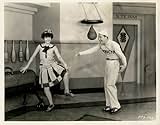VALUTAZIONE IMDb
5,6/10
416
LA TUA VALUTAZIONE
Aggiungi una trama nella tua linguaA musical revue that has Paramount stars and contract-players doing unrelated short sketches and elaborately staged song-and-dance numbers like a duet on a giant cuckoo clock and Clara Bow s... Leggi tuttoA musical revue that has Paramount stars and contract-players doing unrelated short sketches and elaborately staged song-and-dance numbers like a duet on a giant cuckoo clock and Clara Bow singing aboard a navy vessel.A musical revue that has Paramount stars and contract-players doing unrelated short sketches and elaborately staged song-and-dance numbers like a duet on a giant cuckoo clock and Clara Bow singing aboard a navy vessel.
- Premi
- 3 vittorie totali
Charles 'Buddy' Rogers
- Buddy Rogers - Episode 'Love Time'
- (as Buddy Rogers)
Recensioni in evidenza
Sad to say I recently saw an abbreviated version of Paramount On Parade with about only 60% of the numbers and acts in the edited version I saw. Fortunately I do remember seeing the whole film in years gone by.
Paramount's biggest star in those days was Maurice Chevalier who gets to be in three numbers, one of them being the finale. He also had the biggest hits of the show with All I Want Is Just One Girl and Up On Top Of A Rainbow. His third number the Poor Apache is an Apache number if Mack Sennett had choreographed it.
The White Mountain studio made both an English and French version and in the French version Jeanette MacDonald was mistress of ceremonies as opposed to comedian Skeets Gallagher for the English. She also was given a number in the French one that we in America weren't privileged to hear. I'm told it's quite lovely.
William Powell and Clive Brook play Philo Vance and Sherlock Holmes in a murder mystery satire where they annoy Warner Oland as Fu Manchu with insisting on dragging in other suspects. Eugene Palette and Jack Oakie are also in the skit as well.
Cut out of the version I just saw was Dennis King, Broadway star who had just repeated his role as Francois Villon in The Vagabond King. That film doesn't hold up well for a number of reasons, but his number Nichavo in Paramount On Parade is a stirring song that King's virile baritone takes to easily. King did much better on stage than on the screen although he scored very well in his next film with Laurel and Hardy, Fra Diavolo.
The finale is Maurice Chevalier with Up On Top Of A Rainbow done with a hundred chorus girls as well. The song and Maurice are fine, but these kind of numbers really needed Busby Berkeley to show how its done.
I'm a big old sucker for these all star films which had a brief run during the early days of sound and then were revived during World War II as morale boosters. I only wish a complete version was available out there.
Paramount's biggest star in those days was Maurice Chevalier who gets to be in three numbers, one of them being the finale. He also had the biggest hits of the show with All I Want Is Just One Girl and Up On Top Of A Rainbow. His third number the Poor Apache is an Apache number if Mack Sennett had choreographed it.
The White Mountain studio made both an English and French version and in the French version Jeanette MacDonald was mistress of ceremonies as opposed to comedian Skeets Gallagher for the English. She also was given a number in the French one that we in America weren't privileged to hear. I'm told it's quite lovely.
William Powell and Clive Brook play Philo Vance and Sherlock Holmes in a murder mystery satire where they annoy Warner Oland as Fu Manchu with insisting on dragging in other suspects. Eugene Palette and Jack Oakie are also in the skit as well.
Cut out of the version I just saw was Dennis King, Broadway star who had just repeated his role as Francois Villon in The Vagabond King. That film doesn't hold up well for a number of reasons, but his number Nichavo in Paramount On Parade is a stirring song that King's virile baritone takes to easily. King did much better on stage than on the screen although he scored very well in his next film with Laurel and Hardy, Fra Diavolo.
The finale is Maurice Chevalier with Up On Top Of A Rainbow done with a hundred chorus girls as well. The song and Maurice are fine, but these kind of numbers really needed Busby Berkeley to show how its done.
I'm a big old sucker for these all star films which had a brief run during the early days of sound and then were revived during World War II as morale boosters. I only wish a complete version was available out there.
Well much of this Paramount landmark talkie is missing but what remains is entertaining and it's fun to see the old stars in their primes. Copying MGM's Hollywood Revue of 1929, which earned a best picture Oscar nomination and was a smash, Paramount on Parade has a lot of talent but the film seems cheesy compared to the MGM revue. However, this served as the talkie debut of a lot of stars on the Paramount lot. Among the major names: Clara Bow, Maurice Chevalier, Kay Francis, William Powell, Jean Arthur, Gary Cooper, Nancy Carroll, Ruth Chatterton, Fay Wray, Fredric March, Lillian Roth, Buddy Rogers. And also Jack Oakie, Mitzi Green, Leon Errol, Harry Green, Stu Erwin, Cecil Cunningham, Warner Oland, Eugene Palette, Clive Brook, Skeets Gallagher, Al Norman, Mary Brian, Zelma O'Neal, Helen Kane, George Bancroft, Mischa Auer, etc.
Most of the skits are duds but the musical numbers of funny and snappy, especially Chevalier in "Sweeping Away the Clouds," Helen Kane in a "Poop-a-Doop" classroom number, 8-year-old Mitzi Green doing impressions, Clara Bow in her splashy Navy number, Nancy Carroll quite good in her "shoe" dance, and Jack Oakie and Zelma O'Neal in their gym number.
Where the MGM film had unity via a master of ceremony (Jack Benny) this film seems like a bunch of "shorts" strung together but maybe that's because of the missing material.
Most at ease among the many big stars are Clara Bow and Maurice Chevalier who are energetic, snappy, and not afraid of the mike..... Worth a look.
Most of the skits are duds but the musical numbers of funny and snappy, especially Chevalier in "Sweeping Away the Clouds," Helen Kane in a "Poop-a-Doop" classroom number, 8-year-old Mitzi Green doing impressions, Clara Bow in her splashy Navy number, Nancy Carroll quite good in her "shoe" dance, and Jack Oakie and Zelma O'Neal in their gym number.
Where the MGM film had unity via a master of ceremony (Jack Benny) this film seems like a bunch of "shorts" strung together but maybe that's because of the missing material.
Most at ease among the many big stars are Clara Bow and Maurice Chevalier who are energetic, snappy, and not afraid of the mike..... Worth a look.
This was the type of variety show which most of the studios made which was popular in the early days of sound. In this case, the film consists of various short sketches, including musical numbers, comedy bits, and even a dramatic scene. The stars include Maurice Chevalier, Clara Bow, Ruth Chatterton, Fredric March, Gary Cooper, George Bancroft, Jack Oakie, Skeets Gallagher, Buddy Rogers, Kay Francis, Jean Arthur, Mary Brian, Fay Wray, Evelyn Brent, Leon Errol, William Powell, Warner Oland, Clive Brook, Eugene Pallette, Lillian Roth, Stu Erwin, Helen Kane, Nancy Carroll, and Mitzi Green.
Paramount also enlisted a posse of directors, including Edmund Goulding, Dorothy Arzner, Ernst Lubitsch, Rowland V. Lee, Victor Scherzinger, and more. Several of the film's segments, including a few in early Technicolor, were missing from the copy that I watched. In fact, the segment featuring Cooper, Brian, Arthur and Wray only consisted of the intro. My favorite segments include the very silly detective bit with Clive Brook as Sherlock Holmes, Powell as Philo Vance, and Oland as Fu Manchu; Chevalier and Brent in a lover's quarrel; Ruth Chatterton as a sad French prostitute who sings a song to American G. I.s (including March) about to return home from WWI; and a comedy piece with Chevalier as a gendarme patrolling a park popular with lovers. Most of the song and dance numbers were largely forgettable, though. Still, it was nice to see for a different look at the various stars.
Paramount also enlisted a posse of directors, including Edmund Goulding, Dorothy Arzner, Ernst Lubitsch, Rowland V. Lee, Victor Scherzinger, and more. Several of the film's segments, including a few in early Technicolor, were missing from the copy that I watched. In fact, the segment featuring Cooper, Brian, Arthur and Wray only consisted of the intro. My favorite segments include the very silly detective bit with Clive Brook as Sherlock Holmes, Powell as Philo Vance, and Oland as Fu Manchu; Chevalier and Brent in a lover's quarrel; Ruth Chatterton as a sad French prostitute who sings a song to American G. I.s (including March) about to return home from WWI; and a comedy piece with Chevalier as a gendarme patrolling a park popular with lovers. Most of the song and dance numbers were largely forgettable, though. Still, it was nice to see for a different look at the various stars.
Several scenes are still missing from this 1930 film, but what's left is mostly good stuff, and all interesting from a historical point of view. Would you like to see Clive Brook as Sherlock Holmes? Here's a rare chance. Would you like to see Clara Bow sing? Here she is. Would you like to see rather too many songs by Maurice Chevalier? Take your pick of several here. Would you like to see names such as Lillian Roth, Helen Kane, Mitzi Green, and Zelma O'Neill, who are only half-remembered today? Now you can. Would you like to see early appearances by William Powell and Fredric March before they made it big in talkies? They're in this.
The musical numbers fall into the 'ok' camp; they are largely static and stagey, and rather old-fashioned, but no more so than any other early talkie revue film. A lot of the film drags (notably Helen Kane's Boop-de-doop school lesson, and the links by Jack Oakie et al) but as a piece of history, it is fine. It should be a candidate for restoration if the whole film survives in a vault somewhere; let's hope so.
The musical numbers fall into the 'ok' camp; they are largely static and stagey, and rather old-fashioned, but no more so than any other early talkie revue film. A lot of the film drags (notably Helen Kane's Boop-de-doop school lesson, and the links by Jack Oakie et al) but as a piece of history, it is fine. It should be a candidate for restoration if the whole film survives in a vault somewhere; let's hope so.
A couple of years into the Talkie revolution, several studios put on feature-length revues to promote their brand, of which Paramount's effort seems to have been better than most, even though it has not worn particularly well since. (Also the print I watched was notably fuzzy and dim.)
Deservedly, it gives generous exposure to Maurice Chevalier, who had just rescued the studio's fortunes with his Ruritanian romance 'The Love Parade', just as the Wall Street crash was threatening to ruin Hollywood. In particular, his energetic closing act, 'Sweeping the Clouds Away', accompanied by an endless line of leggy beauties, was clearly meant as a cheer-up call for the Depression-hit masses.
As for the other performers, I can only say that they remind us of the transience of fame (at a range of nearly a century). Not one in ten of these names mean anything to us today. Jack Oakie seems to occupy second place, and although I have often enjoyed his work, I think he was personality rather than artistry. Interesting to catch a glimpse of the young Frederick March. Otherwise, Gary Cooper, Clara Bow and Fay Wray more-or-less complete the roll of memorable stars.
Deservedly, it gives generous exposure to Maurice Chevalier, who had just rescued the studio's fortunes with his Ruritanian romance 'The Love Parade', just as the Wall Street crash was threatening to ruin Hollywood. In particular, his energetic closing act, 'Sweeping the Clouds Away', accompanied by an endless line of leggy beauties, was clearly meant as a cheer-up call for the Depression-hit masses.
As for the other performers, I can only say that they remind us of the transience of fame (at a range of nearly a century). Not one in ten of these names mean anything to us today. Jack Oakie seems to occupy second place, and although I have often enjoyed his work, I think he was personality rather than artistry. Interesting to catch a glimpse of the young Frederick March. Otherwise, Gary Cooper, Clara Bow and Fay Wray more-or-less complete the roll of memorable stars.
Lo sapevi?
- QuizOf the original 20 individual sequences, seven of them were filmed in 2-strip Technicolor: the opening sequence: 'Showgirls on Parade', Nino Martini's 'Come Back to Sorrento,' Harry Green's 'Isadore the Toreador' with Kay Francis, Dennis King's 'Nitchavo,' 'Girl of My Dreams', with Richard Arlen, Jean Arthur, Mary Brian, Virginia Bruce, Gary Cooper, James Hall, Phillips Holmes, David Newell, Joan Peers, and Fay Wray, of which only the B&W introduction survives, and the 'Rainbow Revels' finale featuring Maurice Chevalier singing 'Sweeping the Clouds Away', which also survives in B&W. The total Technicolor footage was 2517 feet (768 m), or about 28 minutes.
- BlooperThe re-release opening credits credit producer Jesse L. Lasky as "Jessie" L. Lasky.
- Citazioni
Jack Oakie: It's a mystery play written especially for me!
- Versioni alternativeVersion for distribution of the original film in Romania, titled Parada Paramount (1930) included additional sketches by Romanian actors Ion Ian-Covescu and Pola Iliescu
- ConnessioniAlternate-language version of Parada Paramount (1930)
- Colonne sonoreAll I Want Is Just One Girl
Music by Richard A. Whiting
Lyrics by Leo Robin
Sung by Maurice Chevalier
Sung also by Mitzi Green
I più visti
Accedi per valutare e creare un elenco di titoli salvati per ottenere consigli personalizzati
- How long is Paramount on Parade?Powered by Alexa
Dettagli
- Data di uscita
- Paese di origine
- Lingue
- Celebre anche come
- Paramount on Parade
- Luoghi delle riprese
- Azienda produttrice
- Vedi altri crediti dell’azienda su IMDbPro
- Tempo di esecuzione
- 1h 42min(102 min)
- Colore
- Proporzioni
- 1.20 : 1
Contribuisci a questa pagina
Suggerisci una modifica o aggiungi i contenuti mancanti

